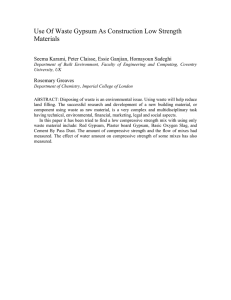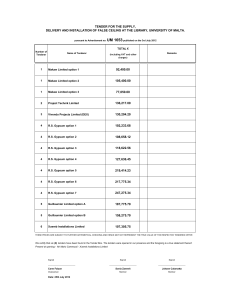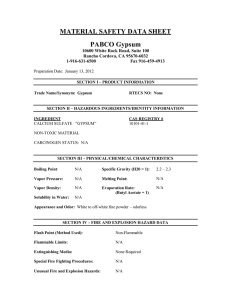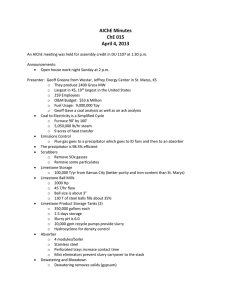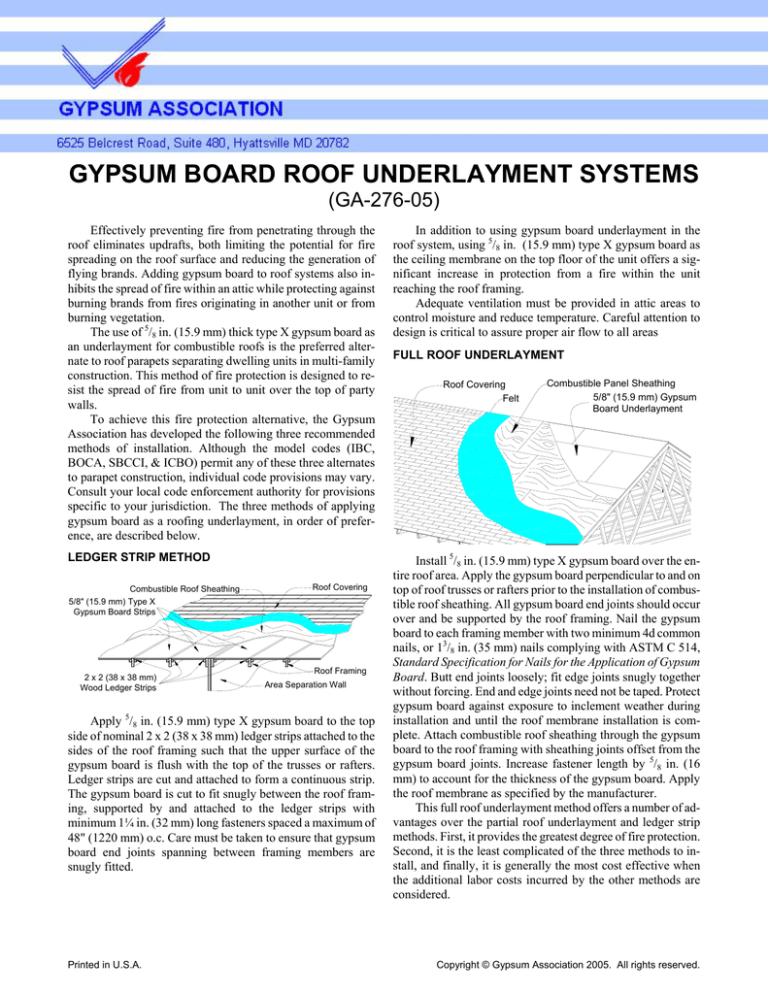
GYPSUM BOARD ROOF UNDERLAYMENT SYSTEMS
(GA-276-05)
Effectively preventing fire from penetrating through the
roof eliminates updrafts, both limiting the potential for fire
spreading on the roof surface and reducing the generation of
flying brands. Adding gypsum board to roof systems also inhibits the spread of fire within an attic while protecting against
burning brands from fires originating in another unit or from
burning vegetation.
The use of 5/8 in. (15.9 mm) thick type X gypsum board as
an underlayment for combustible roofs is the preferred alternate to roof parapets separating dwelling units in multi-family
construction. This method of fire protection is designed to resist the spread of fire from unit to unit over the top of party
walls.
To achieve this fire protection alternative, the Gypsum
Association has developed the following three recommended
methods of installation. Although the model codes (IBC,
BOCA, SBCCI, & ICBO) permit any of these three alternates
to parapet construction, individual code provisions may vary.
Consult your local code enforcement authority for provisions
specific to your jurisdiction. The three methods of applying
gypsum board as a roofing underlayment, in order of preference, are described below.
LEDGER STRIP METHOD
Combustible Roof Sheathing
5/8" (15.9 mm) Type X
Gypsum Board Strips
2 x 2 (38 x 38 mm)
Wood Ledger Strips
Roof Covering
Roof Framing
Area Separation Wall
Apply 5/8 in. (15.9 mm) type X gypsum board to the top
side of nominal 2 x 2 (38 x 38 mm) ledger strips attached to the
sides of the roof framing such that the upper surface of the
gypsum board is flush with the top of the trusses or rafters.
Ledger strips are cut and attached to form a continuous strip.
The gypsum board is cut to fit snugly between the roof framing, supported by and attached to the ledger strips with
minimum 1¼ in. (32 mm) long fasteners spaced a maximum of
48" (1220 mm) o.c. Care must be taken to ensure that gypsum
board end joints spanning between framing members are
snugly fitted.
Printed in U.S.A.
In addition to using gypsum board underlayment in the
roof system, using 5/8 in. (15.9 mm) type X gypsum board as
the ceiling membrane on the top floor of the unit offers a significant increase in protection from a fire within the unit
reaching the roof framing.
Adequate ventilation must be provided in attic areas to
control moisture and reduce temperature. Careful attention to
design is critical to assure proper air flow to all areas
FULL ROOF UNDERLAYMENT
Roof Covering
Felt
Combustible Panel Sheathing
5/8" (15.9 mm) Gypsum
Board Underlayment
Install 5/8 in. (15.9 mm) type X gypsum board over the entire roof area. Apply the gypsum board perpendicular to and on
top of roof trusses or rafters prior to the installation of combustible roof sheathing. All gypsum board end joints should occur
over and be supported by the roof framing. Nail the gypsum
board to each framing member with two minimum 4d common
nails, or 13/8 in. (35 mm) nails complying with ASTM C 514,
Standard Specification for Nails for the Application of Gypsum
Board. Butt end joints loosely; fit edge joints snugly together
without forcing. End and edge joints need not be taped. Protect
gypsum board against exposure to inclement weather during
installation and until the roof membrane installation is complete. Attach combustible roof sheathing through the gypsum
board to the roof framing with sheathing joints offset from the
gypsum board joints. Increase fastener length by 5/8 in. (16
mm) to account for the thickness of the gypsum board. Apply
the roof membrane as specified by the manufacturer.
This full roof underlayment method offers a number of advantages over the partial roof underlayment and ledger strip
methods. First, it provides the greatest degree of fire protection.
Second, it is the least complicated of the three methods to install, and finally, it is generally the most cost effective when
the additional labor costs incurred by the other methods are
considered.
Copyright © Gypsum Association 2005. All rights reserved.
PARTIAL ROOF UNDERLAYMENT
Install 5/8 in. (15.9 mm) type X gypsum board under the
combustible roof sheathing on both sides of the party wall for
not less than the minimum distance required by the code. Apply the gypsum board on top of roof framing, with the paperbound edge perpendicular to the framing, prior to the installation of combustible roof sheathing. All gypsum board ends
should occur over and be supported by the roof framing. Nail
the gypsum board to each framing member with at least two
minimum 4d common nails, or 13/8 in. (35 mm) gypsum wallboard nails. Butt end joints loosely; fit edge joints snugly
together without forcing. End and edge joints need not be
taped. Protect gypsum board against exposure to inclement
weather during installation and until the roof membrane installation is complete. Shim all remaining trusses and rafters as
necessary to provide a straight and uniform base for the attachment of the combustible roof sheathing. Attach roof
sheathing through the gypsum board to the roof framing with
sheathing joints offset from the gypsum board joints. Increase
fastener length by 5/8 in. (16 mm) to account for the thickness
of the gypsum board and shims. Apply the roof membrane as
specified by the manufacturer.
This second method offers easy attachment of the gypsum
board to the roof framing, compared to the ledger strip method.
It does however require shimming the roof framing that is not
protected with the gypsum board. As an alternate to shimming,
two different sizes of rafters or trusses may be used. In typical
multi-family housing where individual units are relatively narrow, it is generally more economical to cover the entire roof.
Roof Covering
Combustible Roof
Sheathing
5/8" (15.9 mm) Type X
Gypsum Board
5/8" (15.9 mm) Wood Shim
Roof Framing
Area Separation Wall
COMPARISON OF BURN-THROUGH TIMES WHEN
GYPSUM BOARD IS ADDED
Tests have been conducted to compare the burn-through
times of roofs using gypsum board underlayment to those
without gypsum board underlayment. These tests demonstrate
the dramatic increase in the amount of time required to burn
through a roof into the attic space when gypsum board underlayment is used in conjunction with common roof deck
materials. The burning brand test portion of Methods of Fire
Tests of Roof Coverings (ASTM E 108 & NFPA 256), one of
the standard tests used to evaluate roof covering materials, was
used in the Gypsum Association test program. The Class A
brand was used in the test to provide the most severe test conditions. The results of this comparative testing are summarized
in Table 1.
Dramatic results were also shown on burn-through of
the roof from a fire originating in the attic space when gypsum board underlayment was used.
Table 1
Roof Covering
Cedar Shakes
Cedar Shakes
Cedar Shakes
Cedar Shakes
Fire Retard Cedar Shakes
Fire Retard Cedar Shakes
Asphalt Shingles
Asphalt Shingles
Asphalt Shingles
Asphalt Shingles
Built-Up Roof
Built-Up Roof
Built-Up Roof
Cedar Shingles
Cedar Shingles
Cedar Shingles
Felt
Asphalt
Asphalt
Asphalt
Asphalt
Asphalt
Asphalt
None
None
None
None
None
None
None
None
None
None
Roof Sheathing
1x8
1x8
½" Plywood
½" Plywood
1 x 6, 10" o.c.
1 x 6, 10" o.c.
1x8
1x8
½" Plywood
½" Plywood
½" Plywood
Type X Gypsum
½" Plywood
1 x 4, 8" o.c.
Type X Gypsum
1 x 4, 8" o.c.
Sub-Sheathing
None
Type X Gypsum Board
None
Type X Gypsum Board
None
Type X Gypsum Board
None
½" Reg Gypsum Board
None
Type X Gypsum Board
None
½" Plywood
Type X Gypsum Board
None
1 x 4, 8" o.c.
Type X Gypsum Board
Burn-Through Time
7:20
None
16:45
None
11:25
None
6:20
None
40:30
None
17:30
None
None
2:55
None
None
Test Stopped
7:45
71:09
17:09
70:00
11:40
70:00
6:40
60:50
40:30
*30:00
17:35
27:40
67:00
5:10
72:00
76:35
* Test was terminated at 30:00 because the specimen stopped burning
GA-276-05
Page 2
MEMBERSHIP LIST
2005
AMERICAN GYPSUM
BPB AMERICA INC.
BPB CANADA INC.
CGC INC.
G-P GYPSUM CORPORATION
LAFARGE NORTH AMERICA INC.
NATIONAL GYPSUM COMPANY
PABCO GYPSUM
A Division of PABCO Building Products, LLC.
TEMPLE-INLAND FOREST PRODUCTS CORP.
UNITED STATES GYPSUM COMPANY
GYPSUM ASSOCIATION
6525 Belcrest Road, Ste 480
Hyattsville, MD 20782
301-277-8686
Fax: 301-277-8747
www.gypsum.org
Printed in U.S.A.
Copyright © Gypsum Association 2005. All rights reserved.


